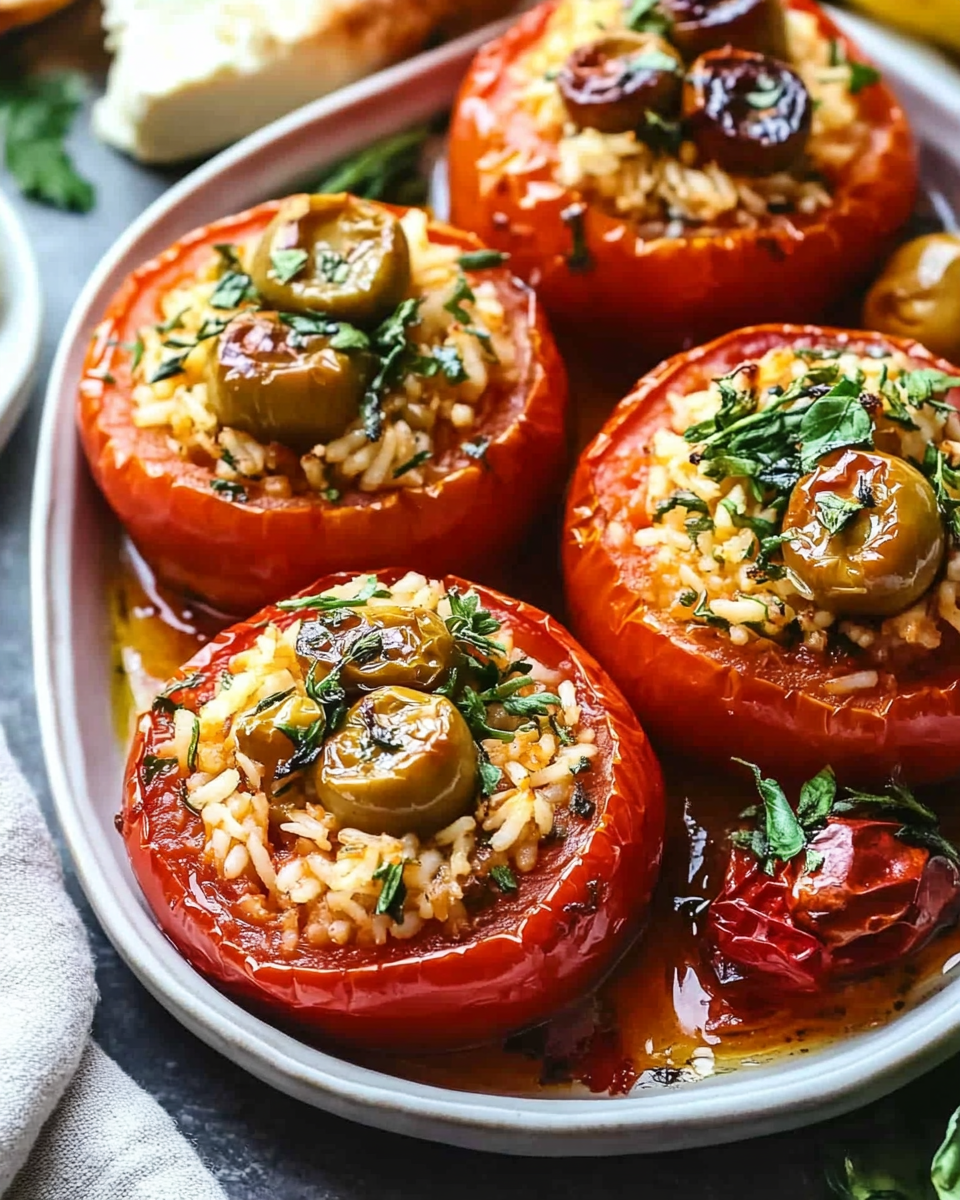Cultural and Culinary Significance
Gemista, which translates to “stuffed,” is a dish that reflects the Greek philosophy of making the most out of seasonal, local ingredients. Traditionally prepared in the summer months when tomatoes are at their peak ripeness, it celebrates the natural sweetness and juiciness of the fruit. While tomatoes are the star, variations may include stuffed peppers, zucchinis, or eggplants, all filled with similar savory mixtures.
This dish showcases the Mediterranean diet’s core principles: fresh vegetables, olive oil, herbs, nuts, and moderate dairy, all contributing to a balanced and healthful meal. The inclusion of olives and feta cheese adds that unmistakable briny and creamy contrast, enhancing the complexity of flavors. Gemista’s rustic appeal lies in its simplicity—each ingredient shines while complementing the others.
Flavor Profile and Texture
One of the most enchanting aspects of Greek Stuffed Tomatoes is the balance of flavors achieved through the combination of ingredients. The sweetness and acidity of the roasted tomatoes create a juicy and tender shell that encases a filling rich with fragrant herbs such as parsley, mint, and dill. These herbs add a refreshing, bright quality that contrasts with the earthiness of rice and the subtle crunch of toasted pine nuts or almonds.
The olives bring a salty, briny kick that cuts through the sweetness of the tomato and the creamy tanginess of feta cheese, providing a savory depth that keeps each bite interesting. The addition of diced potatoes roasted underneath the tomatoes introduces a hearty, comforting element that rounds out the meal.
Texturally, the dish offers a pleasing contrast: the tender roasted tomatoes give way to a slightly chewy, herb-studded rice mixture, punctuated by crunchy nuts and the occasional burst of olive flavor. When served at room temperature, as is customary, the flavors meld beautifully, making it a great dish for leisurely meals or entertaining.
Nutritional Value
Greek Stuffed Tomatoes are not only delicious but also nutritious. Tomatoes themselves are rich in antioxidants like lycopene, vitamin C, and potassium, which support heart health and boost immunity. The rice provides energy-giving carbohydrates, while the nuts contribute healthy fats and protein, enhancing satiety.
The use of olive oil, a cornerstone of Mediterranean cooking, delivers heart-healthy monounsaturated fats and anti-inflammatory benefits. Fresh herbs add vitamins and minerals without adding calories, and the moderate amount of feta cheese supplies calcium and protein, contributing to bone health and muscle maintenance.
This dish is naturally low in saturated fat and can easily be adapted to include additional vegetables or lean proteins, making it suitable for a variety of dietary preferences and needs. Its wholesome ingredients make it a smart choice for anyone seeking balanced nutrition alongside great taste.
Versatility and Serving Suggestions
One of the most appealing features of Gemista is its versatility. While the traditional vegetarian filling is packed with flavor, the recipe lends itself well to customization. For those who prefer meat, adding ground beef or lamb to the rice mixture can transform the dish into a heartier meal. Alternatively, incorporating leafy greens such as spinach or kale can boost the nutrient content and add another layer of flavor.
Gemista pairs wonderfully with simple sides like crusty bread or a light Greek salad, which complements the dish’s freshness and acidity. Serving it with a dollop of tzatziki or alongside roasted vegetables can elevate the meal further.
This dish is perfect for entertaining as it can be prepared ahead of time and served at room temperature, allowing hosts to focus on their guests rather than last-minute cooking. Leftovers taste even better the next day as the flavors continue to meld, making it a practical choice for busy households.
Cooking Techniques and Tips
The key to a successful Greek Stuffed Tomato lies in careful preparation and balance. Scooping out the tomato pulp while preserving the shape of the tomatoes ensures they hold their filling during roasting. Sautéing the onions and garlic before combining them with the rice and tomato pulp develops deeper, sweeter flavors.
Partially cooking the rice before stuffing helps ensure that the grains finish cooking evenly in the oven without becoming mushy or underdone. The roasting process allows the tomatoes to soften and caramelize slightly, enhancing their natural sweetness and melding the filling’s flavors.
Adding diced potatoes to the baking dish is a clever way to incorporate a starchy side that absorbs the delicious juices released during roasting. Drizzling olive oil over the potatoes and tomatoes during cooking promotes browning and adds richness.
For an even more flavorful sauce, some versions include a pinch of chili flakes or a touch of sweetness from honey or raisins, which contrast nicely with the savory filling and intensify the overall taste experience.
Conclusion
Greek Stuffed Tomatoes, or Gemista, are a quintessential Mediterranean dish that offers much more than meets the eye. Combining fresh, wholesome ingredients with a simple yet effective cooking method, this dish is a celebration of flavor, texture, and nutrition. Its balance of sweet tomatoes, fragrant herbs, salty olives, and creamy feta creates a symphony of tastes that delights the senses and nourishes the body.
Versatile and approachable, Gemista is suitable for a variety of occasions, from casual family dinners to festive gatherings. Its ability to be served warm or at room temperature adds to its convenience and appeal. For those looking to explore authentic Greek flavors or incorporate more plant-based meals into their diet, this recipe is a perfect choice.
Adding Greek Stuffed Tomatoes to your website will offer your readers a delicious, nutritious, and culturally rich option that is sure to become a favorite in their kitchens. The dish’s timeless appeal and adaptability ensure it remains relevant and loved, connecting people with the heart of Mediterranean cooking and the joy of sharing good food.






